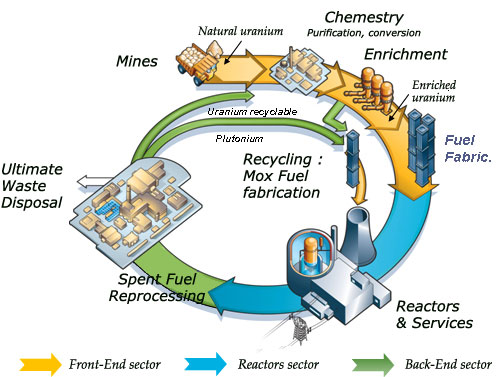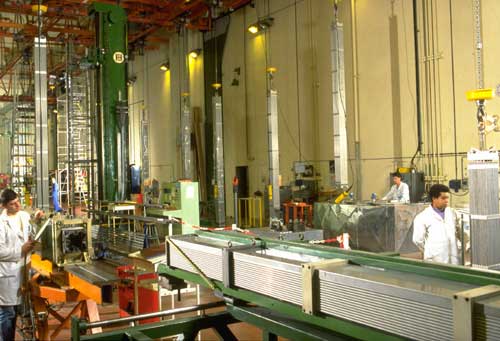The front-end and the back-end of the cycle…
The nuclear fuel cycle includes all nuclear operations ranging from the mining of uranium ore to the reprocessing of spent fuel and the ultimate radioactive waste disposal.
It is indeed a true and closed cycle when nuclei of fissile uranium or plutonium still available when the spent fuel of a reactor is unloaded are recycled in a fresh charge of fuel after reprocessing. Without reprocessing, nuclei of uranium or plutonium go once through the whole process : the cycle is called open.

The French fuel cycle
Nuclear power plants involve a whole cycle of operations and transformations, called « nuclear fuel cycle. « The front-end sector of the cycle – upstream of electricity production – involves looking for uranium deposits, mining, concentration of uranium and its chemical conversion in the form of hexafluoride, and finally its enrichment in the fissile isotope uranium 235 followed by fuel fabrication. The back-end sector – « Downstream » of electricity generation – includes reprocessing of spent fuel, recycling of uranium and plutonium, and waste management.
© AREVA
The central stage of the fuel cycle takes place during the two to three years when the nuclear fuel is burnt in a reactor to produce electricity. Anything that happens before belongs to what is called the cycle “front-end » cycle, and anything that happens after to the “back-end” of the cycle.
Less known and making rarely the headlines, the ‘ front-end’ of the cycle begins with the extraction of the uranium ore which contains generally a very low percentage of uranium. After mining, the ore is converted into a chemical concentrate, known as ‘yellow cake’, which can then be transported over long distances. The extraction and purification of uranium generate mining residues rather important in volume which have to be dealt with, even though they are far less radioactive than the waste produced at the back-end of the cycle.
Before uranium can be enriched into the fissile isotope uranium 235, it must be converted into uranium hexafluoride, a gaseous compound. This is the stage of « conversion”. The next step is enrichment. This step, by far the most expensive and sensitive, is carried out in an isotopic separation plant. Enriched uranium is then used to make fuel assemblies which can then be loaded into the core of a nuclear reactor. The by-product of the enrichment phase is a considerable amount of depleted uranium which is stockpiled,

Fabrication of nuclear fuel assemblies
Manufacture of fuel assemblies in the hall of the French-Belgian factory of Romans in France. The handling of assemblies does not require special precautions because of the low radioactivity of uranium, even enriched in the isotope 235. Pellets of uranium oxide are contained in pencil-shaped ‘fuel rods’
© PHILIPPE LESAGE /AREVA
The « back-end » of the cycle
The main problem to be solved in the cycle back-end is ‘what should be done with the radioactive substances produced by the reactors’?
The fuel is first placed in a storage pool for a period of five years or so, the time to let the most active fission products decrease or disappear. After those five years, a decision is taken as to whether to reprocess or not. If not, then the fuel must be stockpiled as it is. Research is currently being carried out as to the feasibility of a final disposal of spent fuel deep underground, Decisions are still to be taken about such disposals. Meanwhile, the waste stockpiled above ground around the power plants accumulate.
If a reprocessing is decided, the spent fuel is transported to a reprocessing plant where it is stored again a few more years in a local pool. Reprocessing involves separating what can be recycled – uranium and plutonium – from what can be classified as true waste.
Typically 95% of the fuel is made up of uranium, which contains still around 1% of fissile isotope 235, more than natural uranium. The spent fuel contains also a further 1% of plutonium, whose 70% of isotopes are fissile and can produce energy. This uranium can be re-enriched and the plutonium recycled to enter in the composition of fresh fuels to power another reactors. The remaining 4% of the spent fuel are made of fission products and minor actinides. They accounts for almost 98% of its beta and gamma radioactivity. These are the true waste products.
This waste is highly radioactive, but it is conditioned by being embedded in glasses or ceramics which offer less long-term hazards for the environment than the disposal ‘in-state’ of spent fuel without reprocessing. The final disposal of these vitrified waste has yet to be decided, but their mass being much smaller than the spent fuel, their stockpiling in interim storage facilities is less a problem.
Other articles on the subject « Nuclear Fuel »
Cycle Front End
From the extraction of uranium to the fuel fabrication The front-end of the nuclear cycle is the [...]
Isotopic Separation
The access key to the fuel of modern nuclear power plants … and to atomic weapons The uranium fue[...]
Ultracentrifugation
A separation process economical in energy, but proliferating The principle of centrifuges has lon[...]
Gaseous Diffusion
The first enrichment process, a large consumer of electricity The gaseous diffusion process was t[...]
PWR fuel assemblies
Fuel assemblies in the core of PWR Reactors The core of a pressurized water reactor (PWR) is cont[...]
Reactor fuel layout
Fuel assemblies in the core of nuclear reactors The nuclear fuel assemblies, that vary from one r[...]
Plutonium Use
A fissile element produced in nuclear reactors In February 1941 the American physicist Glenn Seab[...]
Pu : Fuel, bomb or Waste ?
Plutonium dark and bright sides … Sensitive material, like the roman god Janus, plutonium h[...]
MOX fuels
Introducing plutonium in nuclear fuels For energy production, plutonum is gold ! One gram of plut[...]
Thorium Fuels
Uranium 233: a fissile nucleus made from thorium Thorium is more abundant than uranium in the Ear[...]